Comparison of Immersion and Portable Ultrasonic Housing to Quantify the Adhesive Bond Thickness and Sizing of Foreign Objects
Abstract
1. Introduction
1.1. Spatially Varying Bondline Quantification for Use in Adhered Composites
1.2. Foreign Object Detection for Laminated Composties
1.3. Technical Contributions of Present Work
2. Portable Ultrasonic Inspection System Housing
3. Experimental Procedure
3.1. Adhesive Bondline Sample Preparation
3.2. Foreign Object Sample Preparation
3.3. Ultrasonic Scanning Systems
4. Results and Discussion
4.1. Adhesive Bondline Results
4.2. Foreign Object Debris Results
5. Conclusions
6. Patents
Author Contributions
Funding
Institutional Review Board Statement
Informed Consent Statement
Data Availability Statement
Acknowledgments
Conflicts of Interest
References
- Rahman, M.R. (Ed.) Advances in Sustainable Polymer Composites; Woodhead Publishing Series in Composites Science and Engineering; Woodhead Publishing: Cambridge, UK, 2021; ISBN 978-0-12-820338-5. [Google Scholar]
- Moore, P.O. (Ed.) Nondestructive Testing Handbook, 3rd ed.; American Society for Nondestructive Testing: Columbus, OH, USA, 2007; Volume 7. [Google Scholar]
- Segreto, T.; Bottillo, A.; Caggiano, A.; Teti, R.; Ricci, F. Full-Volume Ultrasonic Technique for 3D Thickness Reconstruction of CFRP Aeronautical Components. Procedia CIRP 2018, 67, 434–439. [Google Scholar] [CrossRef]
- Tamborrino, R.; Palumbo, D.; Galietti, U.; Aversa, P.; Chiozzi, S.; Luprano, V.A.M. Assessment of the Effect of Defects on Mechanical Properties of Adhesive Bonded Joints by Using Non Destructive Methods. Compos. Part B Eng. 2016, 91, 337–345. [Google Scholar] [CrossRef]
- Poveromo, S.L.; Earthman, J.C. Analysis of “Kiss” Bonds Between Composite Laminates. JOM 2014, 66, 970–978. [Google Scholar] [CrossRef]
- Pisharody, A.P.; Blandford, B.; Smith, D.E.; Jack, D.A. An Experimental Investigation on the Effect of Adhesive Distribution on Strength of Bonded Joints. Appl. Adhes. Sci. 2019, 7, 6. [Google Scholar] [CrossRef]
- Benammar, A.; Drai, R.; Guessoum, A. Detection of Delamination Defects in CFRP Materials Using Ultrasonic Signal Processing. Ultrasonics 2008, 48, 731–738. [Google Scholar] [CrossRef]
- Poudel, A.; Kanneganti, R.; Li, S.; Gupta, L.; Chu, T.P. Classification of Ultrasonic Echo Signals to Detect Embedded Defects in Carbon Fibre Reinforced Plastic Laminates. Int. J. Microstruct. Mater. Prop. 2015, 10, 216–230. [Google Scholar] [CrossRef]
- Barry, T.; Kesharaju, M.; Nagarajah, C.; Palanisamy, S. Defect Characterisation in Laminar Composite Structures Using Ultrasonic Techniques and Artificial Neural Networks. J. Compos. Mater. 2016, 50, 861–871. [Google Scholar] [CrossRef]
- Mohammadkhani, R.; Zanotti Fragonara, L.; Padiyar M., J.; Petrunin, I.; Raposo, J.; Tsourdos, A.; Gray, I. Improving Depth Resolution of Ultrasonic Phased Array Imaging to Inspect Aerospace Composite Structures. Sensors 2020, 20, 559. [Google Scholar] [CrossRef] [PubMed]
- Ma, M.; Cao, H.; Jiang, M.; Sun, L.; Zhang, L.; Zhang, F.; Sui, Q.; Tian, A.; Liang, J.; Jia, L. High Precision Detection Method for Delamination Defects in Carbon Fiber Composite Laminates Based on Ultrasonic Technique and Signal Correlation Algorithm. Materials 2020, 13, 3840. [Google Scholar] [CrossRef]
- Blackman, N.J.; Jack, D.A.; Blandford, B.M. Improvement in the Quantification of Foreign Object Defects in Carbon Fiber Laminates Using Immersion Pulse-Echo Ultrasound. Materials 2021, 14, 2919. [Google Scholar] [CrossRef]
- Adams, R.D.; Cawley, P. A Review of Defect Types and Nondestructive Testing Techniques for Composites and Bonded Joints. NDT Int. 1988, 21, 208–222. [Google Scholar] [CrossRef]
- da Silva, L.F.M.; das Neves, P.J.C.; Adams, R.D.; Spelt, J.K. Analytical Models of Adhesively Bonded Joints—Part I: Literature Survey. Int. J. Adhes. Adhes. 2009, 29, 319–330. [Google Scholar] [CrossRef]
- Davies, P.; Sohier, L.; Cognard, J.-Y.; Bourmaud, A.; Choqueuse, D.; Rinnert, E.; Créac’hcadec, R. Influence of Adhesive Bond Line Thickness on Joint Strength. Int. J. Adhes. Adhes. 2009, 29, 724–736. [Google Scholar] [CrossRef]
- Cognard, J.Y.; Créac’hcadec, R.; Sohier, L.; Leguillon, D. Influence of Adhesive Thickness on the Behaviour of Bonded Assemblies under Shear Loadings Using a Modified TAST Fixture. Int. J. Adhes. Adhes. 2010, 30, 257–266. [Google Scholar] [CrossRef]
- Azari, S.; Papini, M.; Spelt, J.K. Effect of Adhesive Thickness on Fatigue and Fracture of Toughened Epoxy Joints—Part II: Analysis and Finite Element Modeling. Eng. Fract. Mech. 2011, 78, 138–152. [Google Scholar] [CrossRef]
- Liao, L.; Huang, C.; Sawa, T. Effect of Adhesive Thickness, Adhesive Type and Scarf Angle on the Mechanical Properties of Scarf Adhesive Joints. Int. J. Solids Struct. 2013, 50, 4333–4340. [Google Scholar] [CrossRef]
- Rose, J.L.; Avioli, M.J.; Bilgram, R. Feasalbility Study on the Nondestructivig Evaluation of Adhesive Bonded Metal to Metal Bond: An Ultrasonic Pulse Echo Approach. Br. J. Non-Destr. Test. 1983, 25, 67–71. [Google Scholar]
- Chen, J.; Bai, X.; Yang, K.; Ju, B.-F. An Ultrasonic Methodology for Determining the Mechanical and Geometrical Properties of a Thin Layer Using a Deconvolution Technique. Ultrasonics 2013, 53, 1377–1383. [Google Scholar] [CrossRef]
- Hsu, D.K.; Hughes, M.S. Simultaneous Ultrasonic Velocity and Sample Thickness Measurement and Application in Composites. J. Acoust. Soc. Am. 1992, 92, 669–675. [Google Scholar] [CrossRef]
- Gómez Álvarez-Arenas, T.E. Simultaneous Determination of the Ultrasound Velocity and the Thickness of Solid Plates from the Analysis of Thickness Resonances Using Air-Coupled Ultrasound. Ultrasonics 2010, 50, 104–109. [Google Scholar] [CrossRef]
- Maev, R.G.; Shao, H.; Maeva, E.Y. Thickness Measurement of a Curved Multilayered Polymer System by Using an Ultrasonic Pulse-Echo Method. Mater. Charact. 1998, 41, 97–105. [Google Scholar] [CrossRef]
- Greco De Sousa, A.V.; De Albuquerque Pereira, W.C.; Machado, J.C. An Ultrasonic Theoretical and Experimental Approach to Determine Thickness and Wave Speed in Layered Media. IEEE Trans. Ultrason. Ferroelectr. Freq. Control 2007, 54, 386–393. [Google Scholar] [CrossRef]
- Stair, S.; Moore, D.G.; Nelson, C.L. Bondline Boundary Assessment of Cohesive Bonded Solid Woven Carbon Fiber Composites Using Advanced Diagnostic Methods. In Proceedings of the 19th World Conference on Non-Destructive Testing (WCNDT 2016), Munich, Germany, 13–17 June 2016; Volume 21. [Google Scholar]
- Blandford, B.M. Nondestructive Inspection and Quantification of Carbon Fiber Laminates for Barely Visible Impact Damage and Adhesive Layer Thickness Measurements. Ph.D. Dissertation, Baylor University, Waco, TX, USA, 2020. [Google Scholar]
- Wang, J.; Potter, K.; Hazra, K.; Wisnom, M. Experimental Fabrication and Characterization of Out-of-Plane Fiber Waviness in Continuous Fiber-Reinforced Composites. J. Compos. Mater. 2012, 46, 2041–2053. [Google Scholar] [CrossRef]
- Carraro, P.A.; Maragoni, L.; Quaresimin, M. Influence of Manufacturing Induced Defects on Damage Initiation and Propagation in Carbon/Epoxy NCF Laminates. Adv. Manuf. Polym. Compos. Sci. 2015, 1, 44–53. [Google Scholar] [CrossRef]
- Wang, P.; Lei, H.; Zhu, X.; Chen, H.; Wang, C.; Fang, D. Effect of Manufacturing Defect on Mechanical Performance of Plain Weave Carbon/Epoxy Composite Based on 3D Geometrical Reconstruction. Compos. Struct. 2018, 199, 38–52. [Google Scholar] [CrossRef]
- Ashir, M.; Nocke, A.; Cherif, C. Effect of the Position of Defined Local Defect on the Mechanical Performance of Carbon-Fiber-Reinforced Plastics. Autex Res. J. 2019, 19, 74–79. [Google Scholar] [CrossRef]
- Amenabar, I.; Mendikute, A.; López-Arraiza, A.; Lizaranzu, M.; Aurrekoetxea, J. Comparison and Analysis of Non-Destructive Testing Techniques Suitable for Delamination Inspection in Wind Turbine Blades. Compos. Part B Eng. 2011, 42, 1298–1305. [Google Scholar] [CrossRef]
- Li, S.; Poudel, A.; Chu, T.P. An Image Enhancement Technique for Ultrasonic NDE of CFRP Panels. In Proceedings of the 21st Annual Research Symposium & Spring Conference, Dallas, TX, USA, 19–23 March 2012. [Google Scholar]
- Lu, S.; Dong, H.; Yu, H. Interlaminar Damage Assessment Method of CFRP Laminate Based on Synchrosqueezed Wavelet Transform and Ensemble Principal Component Analysis. Compos. Struct. 2021, 276, 114581. [Google Scholar] [CrossRef]
- Lilly, J. Element Analysis: A Wavelet-Based Method for Analysing Time-Localized Events in Noisy Time Series. Proc. R. Soc. A Math. Phys. Eng. Sci. 2017, 473, 20160776. [Google Scholar] [CrossRef]
- Daubechies, I.; Lu, J.; Wu, H.-T. Synchrosqueezed Wavelet Transforms: An Empirical Mode Decomposition-like Tool. Appl. Comput. Harmon. Anal. 2011, 30, 243–261. [Google Scholar] [CrossRef]

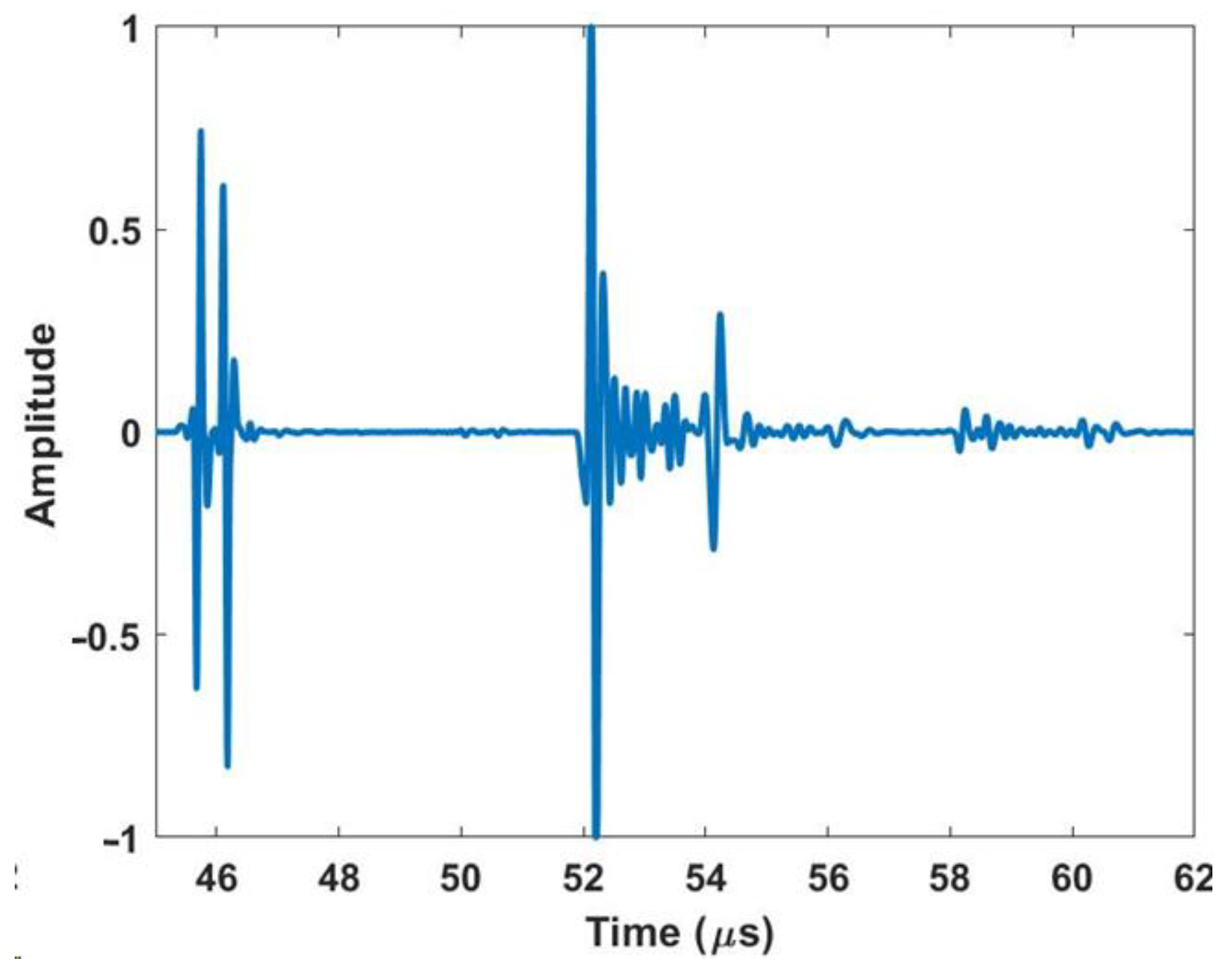
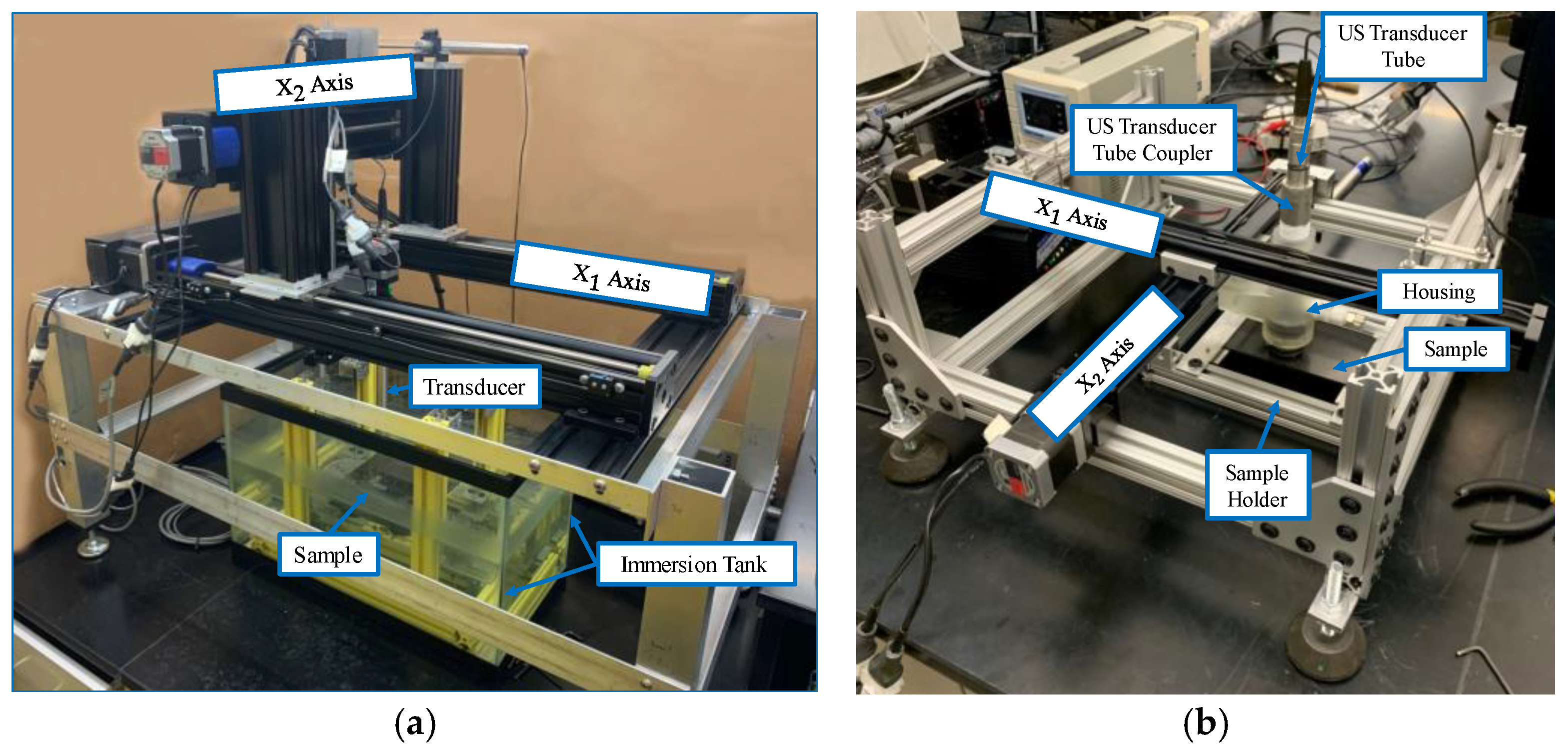
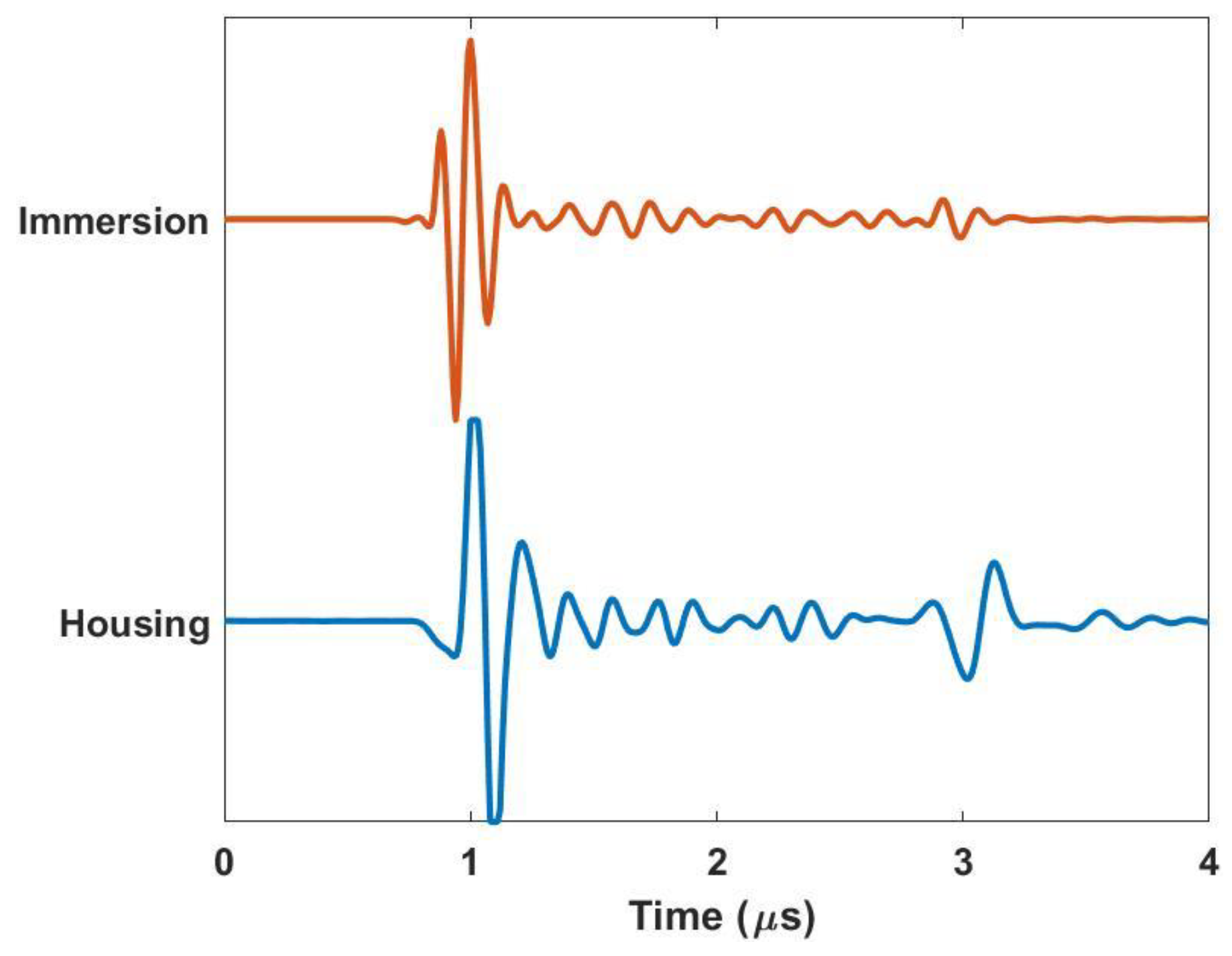
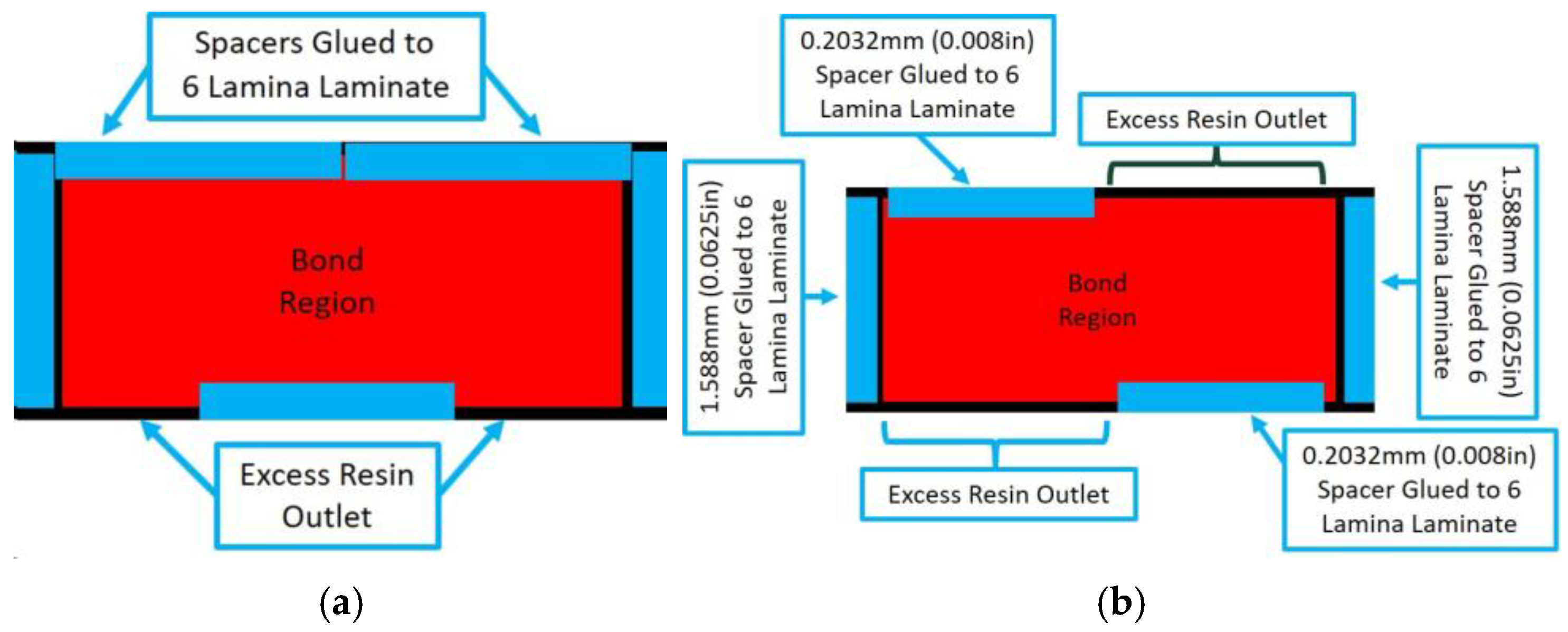
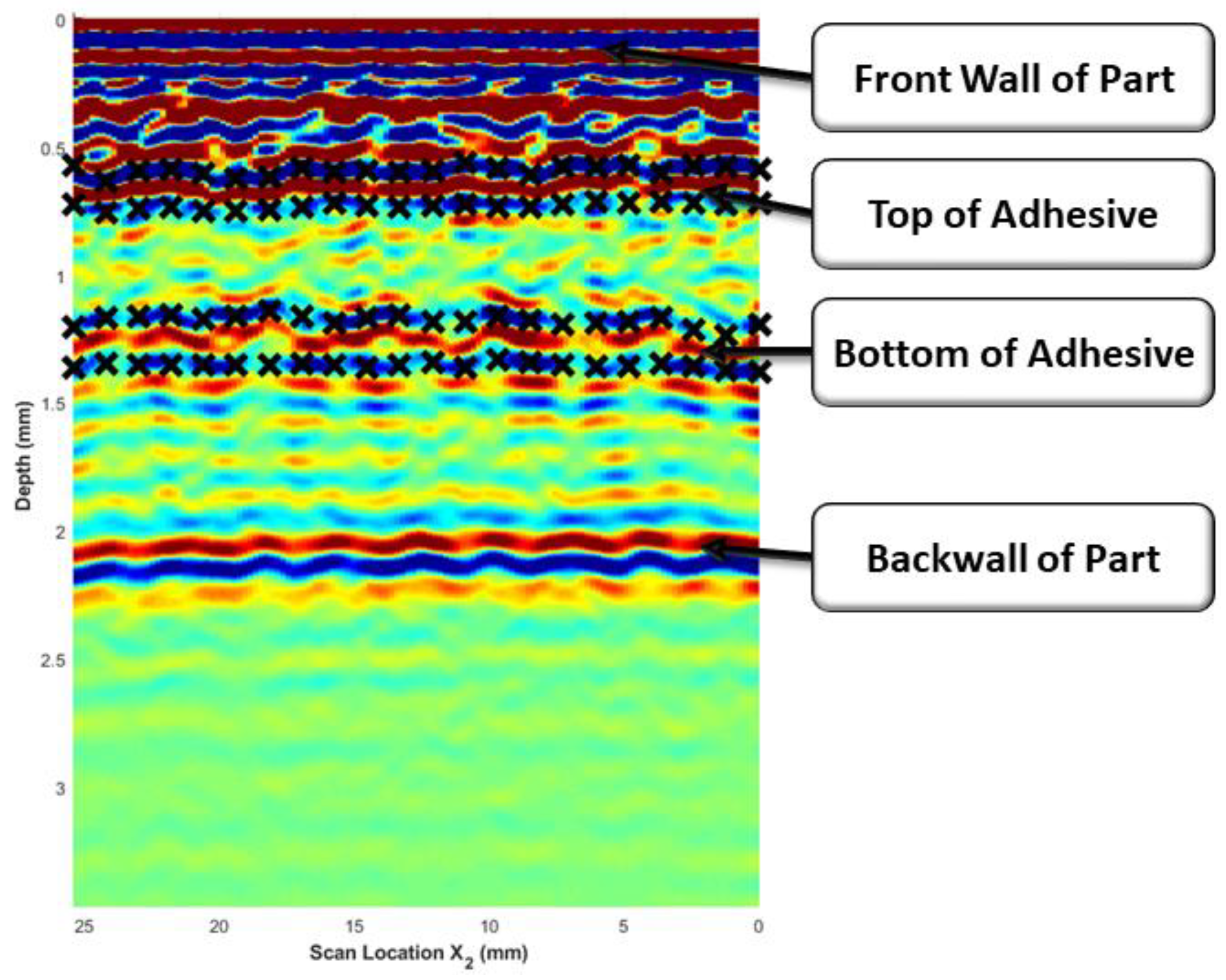


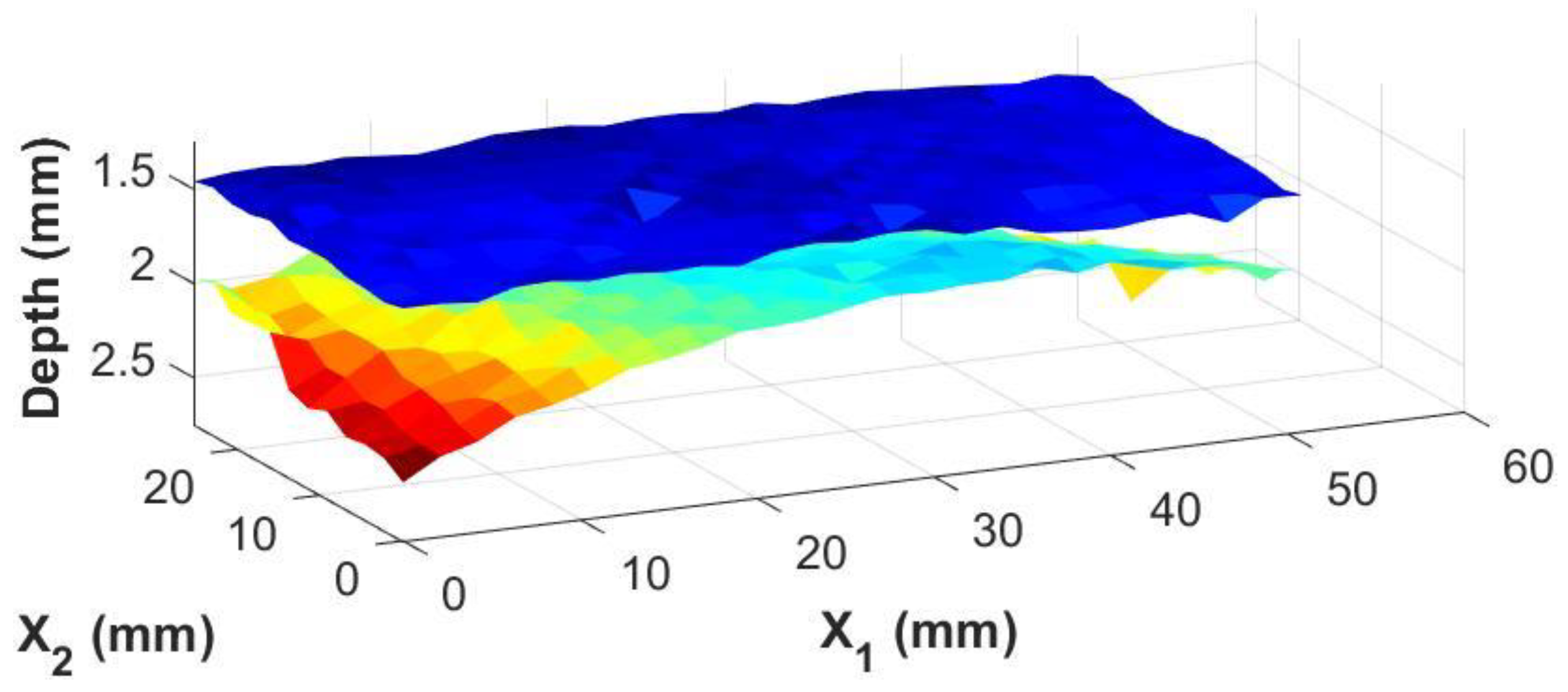
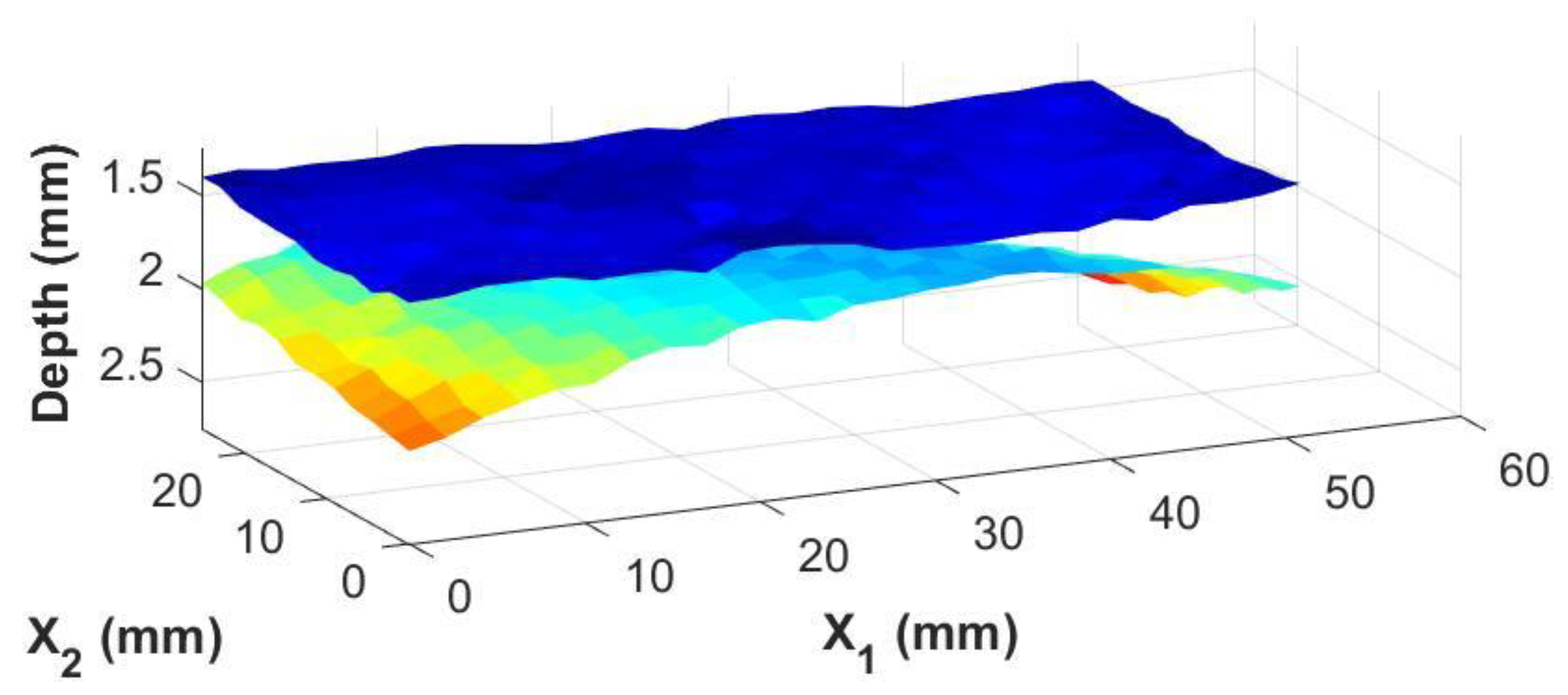
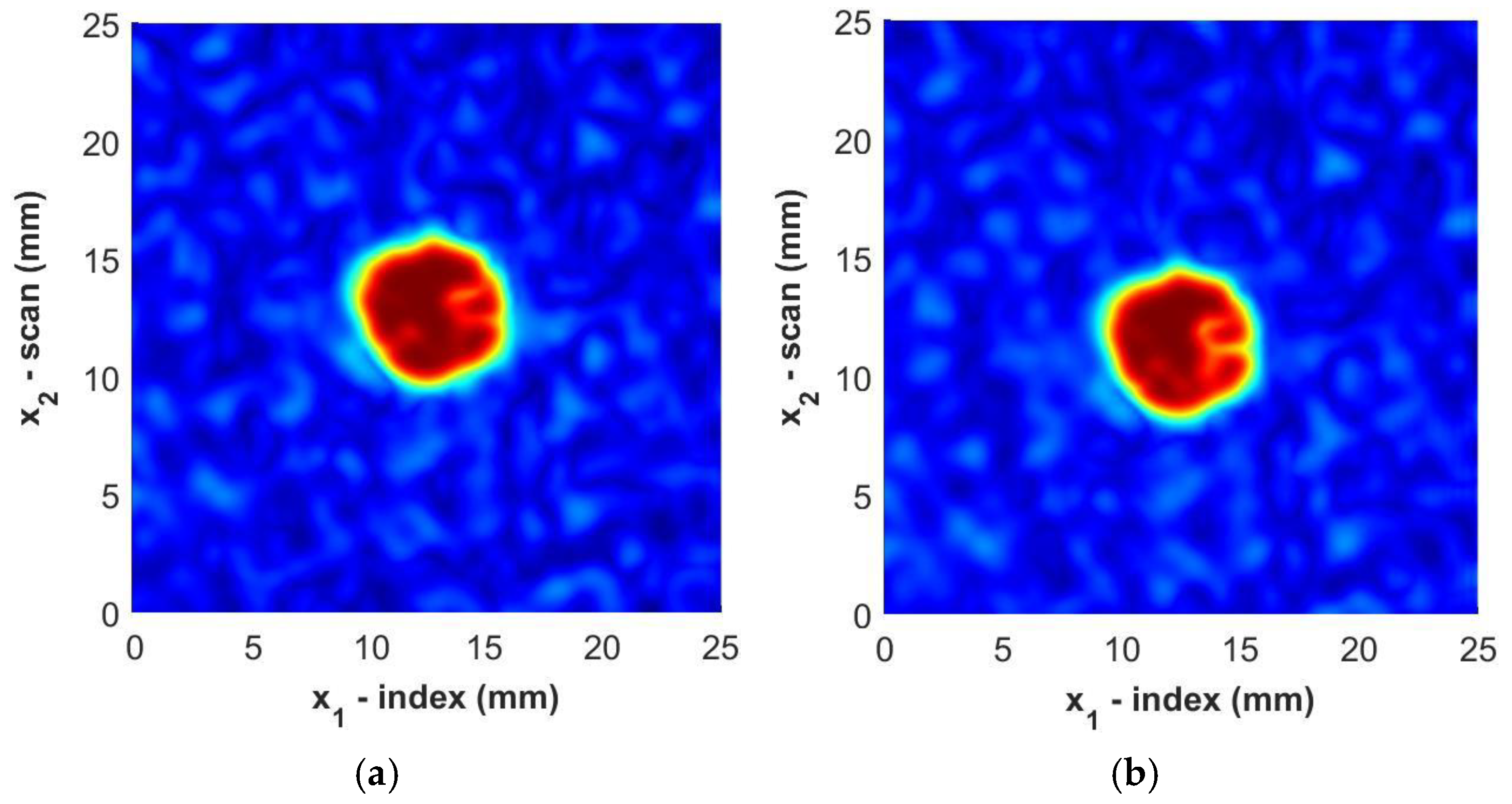
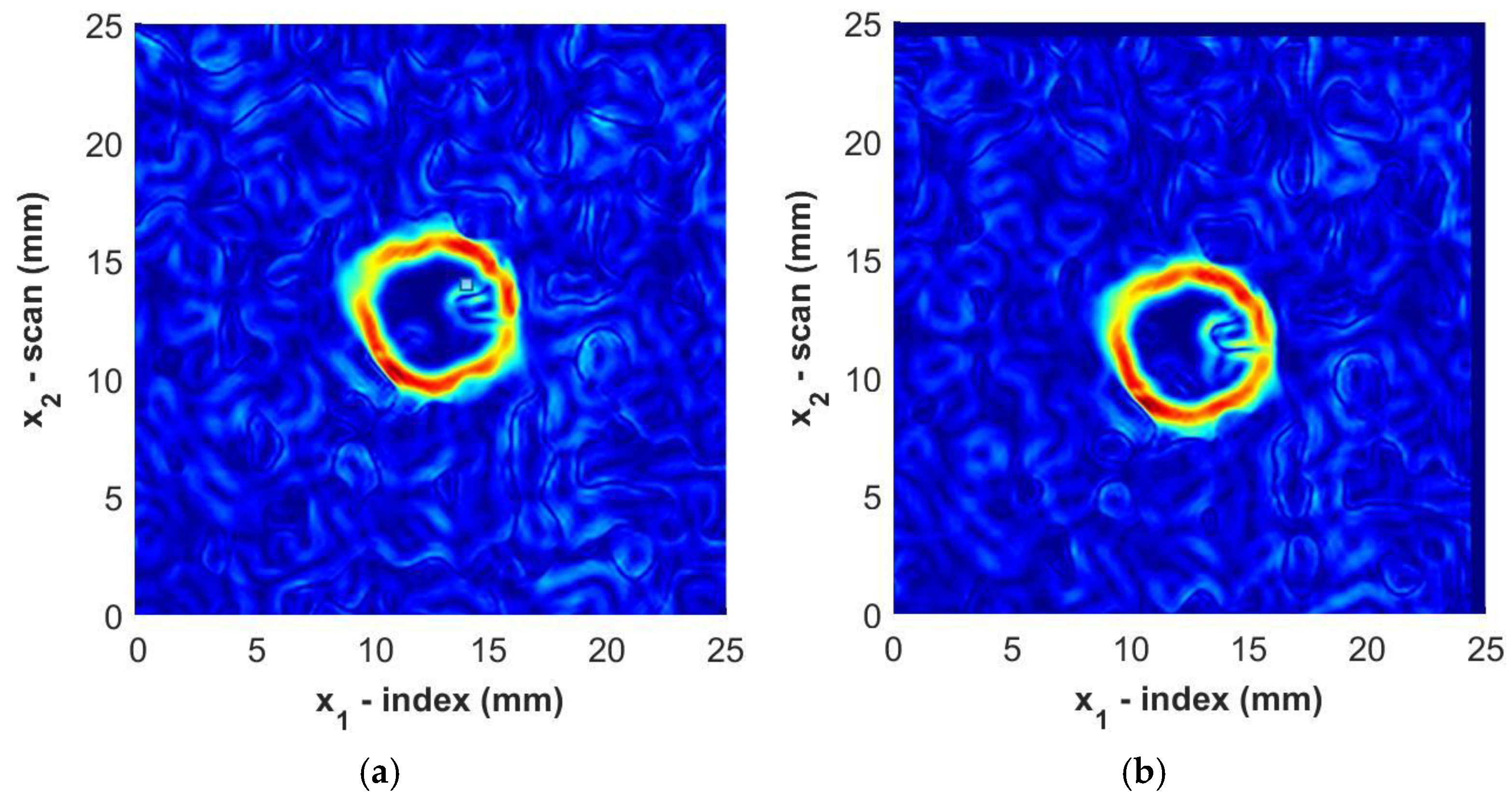
| Foreign Object Label | Diameter (mm) | Area (mm2) |
|---|---|---|
| A1 | 12.67 | 126.08 |
| A2 | 12.55 | 123.70 |
| A3 | 12.55 | 123.70 |
| B1 | 6.08 | 29.03 |
| B2 | 6.18 | 30.00 |
| B3 | 6.10 | 29.22 |
| C1 | 3.10 | 7.55 |
| C2 | 3.13 | 7.69 |
| C3 | 3.09 | 7.50 |
| D1 | 1.52 | 1.81 |
| D2 | 1.61 | 2.04 |
| D3 | 1.52 | 1.81 |
| Sample | Bond 1 | Bond 2 | Bond 3 | Irregular Bond |
|---|---|---|---|---|
| (mm) | 0.02 | 0.04 | 0.03 | 0.06 |
| Foreign Object | Microscopy Area (mm2) | Immersion Area (mm2) | Housing Area (mm2) |
|---|---|---|---|
| A1 | 126.08 | 132.51 | 141.44 |
| A2 | 123.70 | 127.75 | 123.49 |
| A3 | 123.70 | 124.73 | 126.74 |
| B1 | 29.03 | 30.81 | 33.29 |
| B2 | 30.00 | 30.49 | 32.31 |
| B3 | 29.22 | 28.43 | 28.70 |
| C1 | 7.55 | 8.41 | 9.85 |
| C2 | 7.69 | 7.78 | 9.60 |
| C3 | 7.50 | 7.53 | 7.48 |
| D1 | 1.81 | 1.82 | 1.76 |
| D2 | 2.04 | 1.87 | 2.03 |
| D3 | 1.81 | 1.48 | 1.80 |
| Foreign Object | Microscopy (mm) | Immersion (mm) | Error Immersion (mm) | Housing (mm) | Error Portable (mm) |
|---|---|---|---|---|---|
| A1 | 12.67 | 12.99 | 0.32 | 13.42 | 0.75 |
| A2 | 12.55 | 12.75 | 0.20 | 12.54 | 0.01 |
| A3 | 12.55 | 12.60 | 0.05 | 12.70 | 0.15 |
| B1 | 6.08 | 6.26 | 0.18 | 6.51 | 0.43 |
| B2 | 6.18 | 6.23 | 0.05 | 6.41 | 0.23 |
| B3 | 6.10 | 6.02 | 0.08 | 6.05 | 0.05 |
| C1 | 3.10 | 3.27 | 0.17 | 3.54 | 0.44 |
| C2 | 3.13 | 3.15 | 0.02 | 3.50 | 0.37 |
| C3 | 3.09 | 3.10 | 0.01 | 3.09 | 0.00 |
| D1 | 1.52 | 1.52 | 0.00 | 1.50 | 0.02 |
| D2 | 1.61 | 1.54 | 0.07 | 1.61 | 0.00 |
| D3 | 1.52 | 1.37 | 0.15 | 1.51 | 0.01 |
Disclaimer/Publisher’s Note: The statements, opinions and data contained in all publications are solely those of the individual author(s) and contributor(s) and not of MDPI and/or the editor(s). MDPI and/or the editor(s) disclaim responsibility for any injury to people or property resulting from any ideas, methods, instructions or products referred to in the content. |
© 2024 by the authors. Licensee MDPI, Basel, Switzerland. This article is an open access article distributed under the terms and conditions of the Creative Commons Attribution (CC BY) license (https://creativecommons.org/licenses/by/4.0/).
Share and Cite
Blackman, N.J.; Blandford, B.M.; Jack, D.A. Comparison of Immersion and Portable Ultrasonic Housing to Quantify the Adhesive Bond Thickness and Sizing of Foreign Objects. Materials 2024, 17, 5111. https://doi.org/10.3390/ma17205111
Blackman NJ, Blandford BM, Jack DA. Comparison of Immersion and Portable Ultrasonic Housing to Quantify the Adhesive Bond Thickness and Sizing of Foreign Objects. Materials. 2024; 17(20):5111. https://doi.org/10.3390/ma17205111
Chicago/Turabian StyleBlackman, Nathaniel J., Benjamin M. Blandford, and David A. Jack. 2024. "Comparison of Immersion and Portable Ultrasonic Housing to Quantify the Adhesive Bond Thickness and Sizing of Foreign Objects" Materials 17, no. 20: 5111. https://doi.org/10.3390/ma17205111
APA StyleBlackman, N. J., Blandford, B. M., & Jack, D. A. (2024). Comparison of Immersion and Portable Ultrasonic Housing to Quantify the Adhesive Bond Thickness and Sizing of Foreign Objects. Materials, 17(20), 5111. https://doi.org/10.3390/ma17205111








